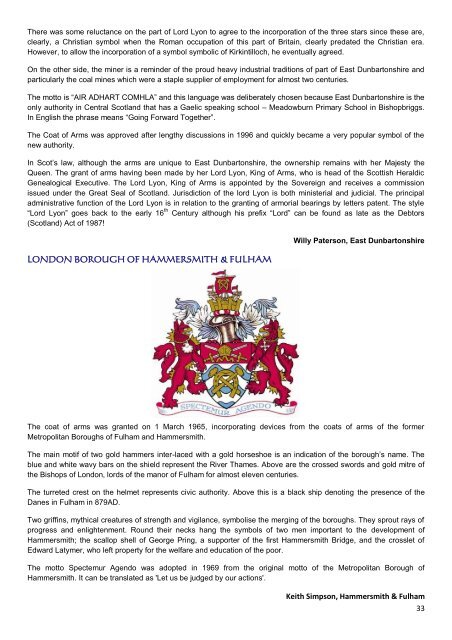The Mace-Bearer Magazine - Guild of Mace-Bearers
The Mace-Bearer Magazine - Guild of Mace-Bearers
The Mace-Bearer Magazine - Guild of Mace-Bearers
Create successful ePaper yourself
Turn your PDF publications into a flip-book with our unique Google optimized e-Paper software.
<strong>The</strong>re was some reluctance on the part <strong>of</strong> Lord Lyon to agree to the incorporation <strong>of</strong> the three stars since these are,<br />
clearly, a Christian symbol when the Roman occupation <strong>of</strong> this part <strong>of</strong> Britain, clearly predated the Christian era.<br />
However, to allow the incorporation <strong>of</strong> a symbol symbolic <strong>of</strong> Kirkintilloch, he eventually agreed.<br />
On the other side, the miner is a reminder <strong>of</strong> the proud heavy industrial traditions <strong>of</strong> part <strong>of</strong> East Dunbartonshire and<br />
particularly the coal mines which were a staple supplier <strong>of</strong> employment for almost two centuries.<br />
<strong>The</strong> motto is “AIR ADHART COMHLA” and this language was deliberately chosen because East Dunbartonshire is the<br />
only authority in Central Scotland that has a Gaelic speaking school – Meadowburn Primary School in Bishopbriggs.<br />
In English the phrase means “Going Forward Together”.<br />
<strong>The</strong> Coat <strong>of</strong> Arms was approved after lengthy discussions in 1996 and quickly became a very popular symbol <strong>of</strong> the<br />
new authority.<br />
In Scot’s law, although the arms are unique to East Dunbartonshire, the ownership remains with her Majesty the<br />
Queen. <strong>The</strong> grant <strong>of</strong> arms having been made by her Lord Lyon, King <strong>of</strong> Arms, who is head <strong>of</strong> the Scottish Heraldic<br />
Genealogical Executive. <strong>The</strong> Lord Lyon, King <strong>of</strong> Arms is appointed by the Sovereign and receives a commission<br />
issued under the Great Seal <strong>of</strong> Scotland. Jurisdiction <strong>of</strong> the lord Lyon is both ministerial and judicial. <strong>The</strong> principal<br />
administrative function <strong>of</strong> the Lord Lyon is in relation to the granting <strong>of</strong> armorial bearings by letters patent. <strong>The</strong> style<br />
“Lord Lyon” goes back to the early 16 th Century although his prefix “Lord” can be found as late as the Debtors<br />
(Scotland) Act <strong>of</strong> 1987!<br />
LONDON BOROUGH OF HAMMERSMITH & FULHAM<br />
Willy Paterson, East Dunbartonshire<br />
<strong>The</strong> coat <strong>of</strong> arms was granted on 1 March 1965, incorporating devices from the coats <strong>of</strong> arms <strong>of</strong> the former<br />
Metropolitan Boroughs <strong>of</strong> Fulham and Hammersmith.<br />
<strong>The</strong> main motif <strong>of</strong> two gold hammers inter-laced with a gold horseshoe is an indication <strong>of</strong> the borough’s name. <strong>The</strong><br />
blue and white wavy bars on the shield represent the River Thames. Above are the crossed swords and gold mitre <strong>of</strong><br />
the Bishops <strong>of</strong> London, lords <strong>of</strong> the manor <strong>of</strong> Fulham for almost eleven centuries.<br />
<strong>The</strong> turreted crest on the helmet represents civic authority. Above this is a black ship denoting the presence <strong>of</strong> the<br />
Danes in Fulham in 879AD.<br />
Two griffins, mythical creatures <strong>of</strong> strength and vigilance, symbolise the merging <strong>of</strong> the boroughs. <strong>The</strong>y sprout rays <strong>of</strong><br />
progress and enlightenment. Round their necks hang the symbols <strong>of</strong> two men important to the development <strong>of</strong><br />
Hammersmith; the scallop shell <strong>of</strong> George Pring, a supporter <strong>of</strong> the first Hammersmith Bridge, and the crosslet <strong>of</strong><br />
Edward Latymer, who left property for the welfare and education <strong>of</strong> the poor.<br />
<strong>The</strong> motto Spectemur Agendo was adopted in 1969 from the original motto <strong>of</strong> the Metropolitan Borough <strong>of</strong><br />
Hammersmith. It can be translated as 'Let us be judged by our actions'.<br />
Keith Simpson, Hammersmith & Fulham<br />
33


